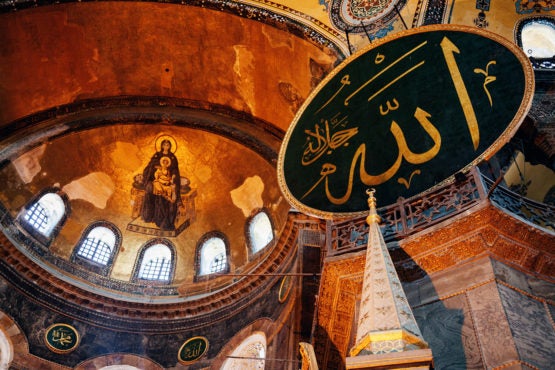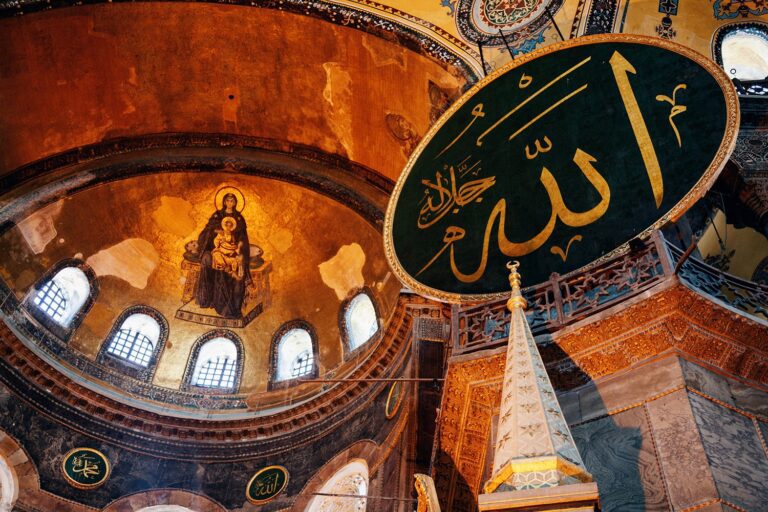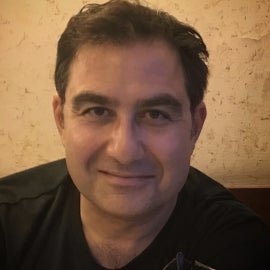With last month’s conversion of Istanbul’s stunning Hagia Sophia into a functioning mosque, Turkish President Recep Erdoğan fulfilled a long-held hope of many Turkish Muslims and his own political party.

Built as a cathedral, Hagia Sophia in Istanbul, Turkey, has also been a mosque and museum and is today again a working mosque. (Image credit: Getty Images)
On July 24, for the first time in nearly 90 years, Muslim worshipers prayed there together, while the imam held a sword – a reminder for many of the building’s conquest throughout Turkish history.
The monumental structure was built in the 6th century by the Roman Emperor Justinian as the largest cathedral in the world. It later became the central building of Greek Orthodox Christianity and the Eastern Roman Empire, known as Byzantium. Hagia Sophia came under Catholic control for a few decades in the 13th century during the Crusades before the Byzantine emperor retook Constantinople.
Then, in 1453, after the Ottoman Empire took control, it became a mosque. After the founding of the modern state of Turkey, Hagia Sophia was transformed into a museum in 1934.
Ali Yaycioğluassociate professor of history specializing in the Ottoman Empire and modern Turkey at School of Humanities and Sciences, discusses the significance of the building. For Yaycıoğlu, a native of Ankara, Turkey, stories of conquest – the idea that a conquering group claimed the Hagia Sophia from the previous one and took full ownership of it – belie the impact each had on the ‘other.
You have written that the conversion of the Hagia Sophia into a mosque has been on the political agenda of Islamist and conservative nationalists in Turkey at least since the 1950s. What are the political and cultural forces at work that enabled the conversion of happen today?
For conservatives, Islamists and conservative nationalists, turning the Hagia Sophia into a museum was seen as a concession to the West, which deeply hurt pious Muslims. According to many right-wing thinkers, it was a symbol of self-colonization on the part of the founders of modern Turkey.
For the founders of the Turkish Republic, on the other hand, this decision symbolized a new claim on Turkish history; it was a matter of trust rather than concession. They believed they could change the status of their most sacred building and turn it into a museum because they had the confidence to do so.
I do not mean that the founders of the Turkish Republic also embraced all the historical heritage of their lands. They are essentially Turkish nationalists. Yet they intended to establish a new relationship with the country’s history by demystifying the Ottoman imperial and politico-religious narrative. The transformation of Hagia Sophia into a museum must be understood in this context. But we must also see that, whatever the real motivation, the 1934 decision has universal value. Thanks to this decision, Hagia Sophia has been considered one of the most important world heritage sites in Turkey and the world.
Today, the decision to convert it into a mosque is very political and is linked to the decline in popularity of President Erdoğan. It appears that Erdoğan thought that this move, a show of strength to domestic and world public opinion, would help him show that he is still capable of making radical decisions despite opposition.
Besides its stunning architecture, the building is also known for its intricate Byzantine mosaics. What is your reaction to the recent decision to cover mosaics during prayers?
They will cover the mosaics with curtains during prayers, which I think is fine provided they open the curtains at other times. You should know that the Ottomans did not touch the mosaics for centuries. It was only later that some mosaics were covered but not destroyed. The Ottomans knew the artistic value of mosaics.
Historians of Islamic art have shown that there was no widespread iconophobia in the premodern Islamic world. Generally there are no human figures in mosques, but it is also known that the Ottomans were not uncomfortable in Hagia Sophia praying under the images of Jesus and Mary.
From the 17th century onwards, we noticed that such icons were gradually considered inappropriate in a mosque. It should be noted that Islamic culture has a diverse history and this history is not linear. In the 19th century, there was a new interest in the mosaics of Hagia Sophia. At the same time, we need to study how the Orthodox Christian community in Istanbul and elsewhere in the empire perceived Hagia Sophia throughout the Ottoman centuries.
Throughout history, every conquering group has claimed Hagia Sophia. Is becoming a mosque again the last chapter in this story of conquest?
No, this is not the case. In fact, Hagia Sophia continued to shape how the Ottomans viewed themselves and the history of their capital over the centuries. It was almost a time tunnel for them, connecting them to the Roman and Byzantine worlds.
They studied its history from Greek sources and linked it to symbols and notables from Islamic traditions, including Quranic and biblical prophets predating Muhammad, such as Solomon, Noah and John the Baptist.
The building itself served as a sort of link between cultures. It was the symbol of Roman political tradition. The Ottoman sultans claimed to be not only sultans, but also Caesar – a Roman emperor – and Hagia Sophia symbolized this universal Roman-Ottoman sovereignty.
In other words, the Ottomans redefined Hagia Sophia for their own spiritual tradition, or perhaps better, their spiritual tradition was redefined by Hagia Sophia.
In the 17th and 18th centuries it continued to play an important role as a political and sacred space. I think it can be said that Hagia Sophia was the most important building in the Ottoman Empire, along with the Kaaba in Mecca and the Dome of the Rock in Jerusalem.
How do theories of conquest explain or fail to explain the importance of Hagia Sophia both in Turkey and for people around the world?
The conquest was important for the Ottomans. This meant the incorporation of existing social, spiritual and material realities into the new regime. It was not simply about erasing existing realities and rebuilding new things, but about constructing new relationships between the past and the present.
The Ottomans transformed themselves through their own conquests, while transforming the lands they had conquered. Hagia Sophia is one of the best examples. The Ottomans changed Hagia Sophia, and they were transformed by it. They transformed the building into a mosque and a symbol of imperial power, and yet their entire conception of imperial architecture was shaped by the Hagia Sophia. Even in today’s Turkey, mosque architecture is often based on the Hagia Sophia, with a large central dome.
Today in Turkey, the Ottoman conquests, particularly that of Constantinople, are viewed in the form of a triumphalist narrative: “The Ottomans came, defeated the Byzantine Empire and built a new civilization from scratch.” . But this account cannot explain why Hagia Sophia is so important.
In contrast, in the West, the popular perception of the Ottoman conquests of the 14th to 16th centuries is that they were brutal and destructive. But this perspective also fails to see that the Ottoman Empire was a product of early modern rather than medieval realities and also fails to understand how the Ottomans gave new meaning to the Hagia Sophia, incorporating its significance historical.
As a historian, what do you think is the most desirable way to maintain and preserve the building’s rich religious and cultural history?
I love Hagia Sophia. And this love is not a religious love. I love it because it is so beautiful, but also because it has dizzying historical, emotional, cosmological and spiritual layers. All these elements are intertwined, not necessarily in a hierarchical and chronological order.
It is an almost timeless building, incorporating elements from the last 1,500 years into its space. I would have preferred the Hagia Sophia to remain a museum. But frankly, the museum didn’t do this building justice either. It was a dry museum. There was no way to hear the mesmerizing acoustics of the building. This became even clearer to me after I was able to attend a Cappella Romana concert at Stanford, in collaboration with my Stanford colleague. Bissera Penchevaprofessor of art and art history, based on his research into the astonishing soundscape of the Hagia Sophia.
It is now a mosque and there is no possibility of changing this status in the near future. It is therefore important to first think about how we can protect the building. Second, let’s think about how it could also function as a mosque-museum. We must find ways to preserve Hagia Sophia, not only as a museum but also as a functioning spiritual center with a diverse and contested history. Hagia Sophia should function as a monument intended to unite people, instead of divide them.



